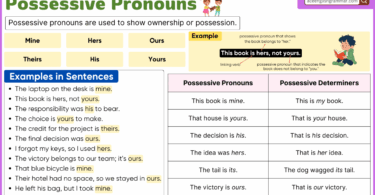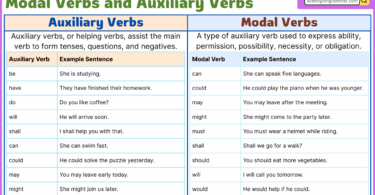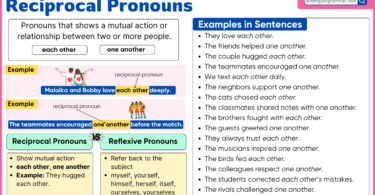A clause is a group of words that contains a subject and a verb. It can express a complete idea (independent clause) or depend on another clause for meaning (dependent clause). Clauses are key to building strong English sentences. This post helps learn the types of clauses with clear examples for better grammar and writing skills.
Table of Contents
What is a Clause?
A clause is a group of words that includes a subject and a predicate (a verb or verb phrase). Unlike phrases, clauses can sometimes express a complete thought.
There are two main types of clauses:
Independent Clause
An independent clause can stand alone as a complete sentence. It has a clear subject and verb and expresses a full idea.
- I am going to the store.
- She is reading a book.
Dependent Clause
A dependent clause cannot stand alone. It adds meaning to the main sentence but needs to be attached to an independent clause to make sense.
- Unless you apologize, I won’t forgive you.
- In order to pass the exam, she studied all night.
Types of Clauses
There are two main types of clauses in English: independent clauses and dependent clauses.
Independent Clause (Main Clause)
An independent clause, also known as a main clause, is a group of words that can stand alone as a complete sentence because it expresses a complete thought. It consists of a subject and a predicate (verb) and can function independently. It doesn’t rely on any other part of the sentence to make sense.
Examples:
- The sun was shining brightly.
- He played the guitar.
- She went to the store.
- He enjoys reading books.
- They are planning a vacation.
Each of these examples can function as a complete sentence by itself because it contains both a subject and a verb, and it expresses a complete thought or action.
Dependent Clause (Subordinate Clause)
A dependent clause, also known as a subordinate clause, is a group of words that contains both a subject and a verb but cannot stand alone as a complete sentence because it does not express a complete thought. Dependent clauses rely on independent clauses to form complete sentences and convey a clear meaning. They are typically used to provide additional information, add complexity, or show relationships within a sentence.
Examples:
- In order to succeed, you must work hard.
- Before I go to bed, I always brush my teeth.
- I don’t know what you want.
- Although he’s talented, he lacks confidence.
- If you don’t water the plants, they will wither.
There are also various types of dependent clauses based on their functions within a sentence:
Adjective Clauses (Relative Clause):
This type of clause describes a noun and usually begins with a relative pronoun (e.g., who, which, that).
Example: The book that I borrowed is interesting.
Adverbial Clauses:
An adverbial clause functions as an adverb, modifying a verb, adjective, or adverb in the main clause. These clauses often answer questions like when, where, why, how, and to what extent.
Example: He ran because he was late. (Answers “why” he ran)
Noun Clause:
A noun clause functions as a noun within a sentence. It can be the subject, object, or complement of a verb.
Example: What you said is important. (Noun clause “What you said” is the subject of the verb “is.”)
Conditional Clause:
A conditional clause expresses a condition, and it is often introduced by words like “if” or “unless.”
Example: If it rains, we will stay home.
Purpose Clause:
A purpose clause indicates the purpose or reason for an action and is usually introduced by words like “so that,” “in order that,” or “to.”
Example: She studied hard so that she could pass the exam.
Result Clause:
A result clause shows the consequence or result of an action and is often introduced by words like “so…that” or “such…that.”
Example: It was so hot that we couldn’t go outside.
Infinitive Clauses:
These clauses use an infinitive verb (e.g., “to + verb”) and can function as nouns, adjectives, or adverbs. For example:
Example: This is the best time to visit.
Time Clause: A time clause indicates when an action takes place and is introduced by words like “when,” “while,” “before,” and “after.”
Example: I will call you when I get home.
Non-restrictive vs. Restrictive Clauses:
Non-restrictive (or non-defining) clauses provide additional, non-essential information and are set off by commas. They do not restrict the meaning of the noun they modify.
Restrictive (or defining) clauses provide essential information and are not set off by commas. They restrict the meaning of the noun they modify.
Example: My sister, who is a doctor, lives in New York.
(The clause “who is a doctor” is non-restrictive.)
Example: The doctor who lives next door is very friendly.
(The clause “who lives next door” is restrictive; it specifies which doctor is being referred to.)
How to Use and Punctuate Clauses Correctly
Using clauses correctly improves sentence structure, clarity, and grammar. Here are 7 essential rules to follow when writing or combining clauses:
1. Use Proper Punctuation for Independent Clauses
When joining two independent clauses, use:
- A comma + coordinating conjunction (and, but, or)
- A semicolon to join without conjunctions
✔ She studied hard, and she passed the test.
✔ She studied hard; she passed the test.
2. Use Commas for Non-Essential (Non-Restrictive) Clauses
Add commas around clauses that provide extra information that isn’t essential to the main point.
✔ The book, which I borrowed from the library, is fantastic.
3. No Commas for Essential (Restrictive) Clauses
Do not use commas when the clause is necessary to the sentence’s meaning.
✔ The book that I borrowed is fantastic.
4. Use Subordinating Conjunctions for Dependent Clauses
Connect dependent clauses using words like because, although, if, unless, when, since, while.
✔ Because it rained, the event was canceled.
✔ She stayed home although she wanted to go.
5. Maintain Parallel Structure in Multi-Clause Sentences
When listing actions or combining clauses, keep the structure and verb forms consistent.
✔ He likes to swim, hike, and bike.
❌ He likes swimming, to hike, and biking.
6. Avoid Comma Splices
Do not connect two independent clauses with just a comma.
❌ She finished the project, she submitted it.
✔ She finished the project, and she submitted it.
7. Avoid Fused Sentences (Run-ons)
Don’t join independent clauses without punctuation or conjunctions.
❌ He cooked dinner he washed the dishes.
✔ He cooked dinner. He washed the dishes.
✔ He cooked dinner, and he washed the dishes.
Coordinate Clauses
Coordinate clauses are independent clauses that are joined together using coordinating conjunctions (FANBOYS: for, and, nor, but, or, yet, so) or semicolons.
Examples:
- She likes coffee, but he prefers tea.
- I’ll go to the store, you can stay here.
- He works hard, but he doesn’t get paid much.
- He’s tired, so he’s going to take a nap.
- She’s busy, and I’m free.
- He’s tall, yet he plays basketball poorly.
- They arrived early, but the event started late.
How to Join Clauses in English
Clauses can be joined in several ways depending on whether you’re combining independent clauses or creating a complex sentence with a dependent clause. Here’s how:
How to Join an Independent Clause
1. Coordinating Conjunctions (FANBOYS)
Use with independent clauses. Add a comma before the conjunction.
- I was tired, but I kept working.
(for, and, nor, but, or, yet, so)
2. Semicolon (;)
Joins two closely related independent clauses without a conjunction.
- She studied hard; she passed the test.
3. Semicolon + Transitional Word
Use a semicolon followed by words like however, therefore, meanwhile.
- He wanted to leave; however, he stayed polite.
4. Colon (:)
Use when the second clause explains or expands the first. Works best in formal or structured writing.
- He had one goal: to win the match.
5. Dash (—)
Adds emphasis or contrast between clauses. Less formal.
- She was late — the traffic was terrible.
6. Subordinating Conjunctions
Join a dependent clause with an independent clause to form a complex sentence.
- Because it rained, the game was canceled.
- Although he was tired, he finished the work.
(because, although, since, while, unless, if, when, etc.)
7. Keep as Separate Sentences
If the ideas are related but don’t need tight connection, use a period.
- She cooked dinner. He set the table.
How to Join a Dependent Clause
A dependent clause cannot stand alone and must be connected to an independent clause. Here’s how to do it correctly:
1. Use a Subordinating Conjunction
Start the dependent clause with words like:
because, although, since, when, if, unless, while, after, before
- Because it was raining, we stayed inside.
2. Comma Rule – Dependent Clause First
When the dependent clause comes before the independent clause, add a comma after it.
- Although he was late, the meeting hadn’t started.
3. No Comma – Independent Clause First
When the dependent clause comes after the independent clause, do not use a comma.
- We stayed inside because it was raining.
FAQs
Q1: What is a clause?
A clause is a group of words that contains a subject and a verb. It can be either independent (a complete thought) or dependent (incomplete and relies on an independent clause).
Q2: What is an independent clause?
An independent clause, also known as a main clause, is a group of words that can stand alone as a complete sentence. It expresses a complete thought.
Q3: What is a dependent clause?
A dependent clause, also called a subordinate clause, is a group of words that cannot stand alone as a sentence because it does not express a complete thought. It relies on an independent clause to make sense.
Q4: How do I identify a dependent clause?
Dependent clauses often begin with subordinating conjunctions (e.g., because, although, if) or relative pronouns (e.g., who, which, that). They typically cannot stand alone as sentences.
Q5: What are some common subordinating conjunctions used in dependent clauses?
Common subordinating conjunctions include because, although, since, while, if, when, and whereas, among others.
Q6: What is a relative clause?
A relative clause is a type of dependent clause that provides more information about a noun in the main clause. It typically begins with a relative pronoun such as “who,” “which,” or “that.”
Read More




Leave a Comment